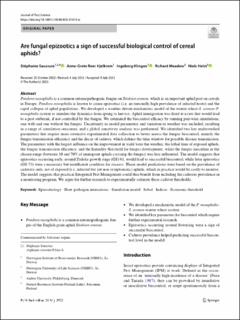| dc.contributor.author | Saussure, Stephanie | |
| dc.contributor.author | Hjelkrem, Anne-Grete Roer | |
| dc.contributor.author | Klingen, Ingeborg | |
| dc.contributor.author | Meadow, Richard | |
| dc.contributor.author | Holst, Niels | |
| dc.date.accessioned | 2024-01-11T13:16:36Z | |
| dc.date.available | 2024-01-11T13:16:36Z | |
| dc.date.created | 2023-09-01T12:39:45Z | |
| dc.date.issued | 2023-07-26 | |
| dc.identifier.citation | Saussure, S., Hjelkrem, A.-G. R., Klingen, I., Meadow, R., & Holst, N. (2023). Are fungal epizootics a sign of successful biological control of cereal aphids? Journal of Pest Science | en_US |
| dc.identifier.issn | 1612-4758 | |
| dc.identifier.uri | https://hdl.handle.net/11250/3111136 | |
| dc.description.abstract | Pandora neoaphidis is a common entomopathogenic fungus on Sitobion avenae, which is an important aphid pest on cereals in Europe. Pandora neoaphidis is known to cause epizootics (i.e. an unusually high prevalence of infected hosts) and the rapid collapse of aphid populations. We developed a weather-driven mechanistic model of the winter wheat-S. avenae-P. neoaphidis system to simulate the dynamics from spring to harvest. Aphid immigration was fixed at a rate that would lead to a pest outbreak, if not controlled by the fungus. We estimated the biocontrol efficacy by running pair-wise simulations, one with and one without the fungus. Uncertainty in model parameters and variation in weather was included, resulting in a range of simulation outcomes, and a global sensitivity analysis was performed. We identified two key understudied parameters that require more extensive experimental data collection to better assess the fungus biocontrol, namely the fungus transmission efficiency and the decay of cadaver, which defines the time window for possible disease transmission. The parameters with the largest influence on the improvement in yield were the weather, the lethal time of exposed aphids, the fungus transmission efficiency, and the humidity threshold for fungus development, while the fungus inoculum in the chosen range (between 10 and 70% of immigrant aphids carrying the fungus) was less influential. The model suggests that epizootics occurring early, around Zadoks growth stage (GS) 61, would lead to successful biocontrol, while later epizootics (GS 73) were a necessary but insufficient condition for success. These model predictions were based on the prevalence of cadavers only, not of exposed (i.e. infected but yet non-symptomatic) aphids, which in practice would be costly to monitor. The model suggests that practical Integrated Pest Management could thus benefit from including the cadavers prevalence in a monitoring program. We argue for further research to experimentally estimate these cadaver thresholds. | en_US |
| dc.language.iso | eng | en_US |
| dc.publisher | Springer Nature | en_US |
| dc.rights | Navngivelse 4.0 Internasjonal | * |
| dc.rights.uri | http://creativecommons.org/licenses/by/4.0/deed.no | * |
| dc.title | Are fungal epizootics a sign of successful biological control of cereal aphids? | en_US |
| dc.type | Peer reviewed | en_US |
| dc.type | Journal article | en_US |
| dc.description.version | publishedVersion | en_US |
| dc.rights.holder | © The Author(s) 2023 | en_US |
| dc.source.journal | Journal of Pest Science | en_US |
| dc.identifier.doi | 10.1007/s10340-023-01674-w | |
| dc.identifier.cristin | 2171665 | |
| dc.relation.project | Norges forskningsråd: 244526 | en_US |
| dc.relation.project | COST (European Cooperation in Science and Technology): FA1405 | en_US |
| cristin.ispublished | true | |
| cristin.fulltext | original | |
| cristin.qualitycode | 1 | |

